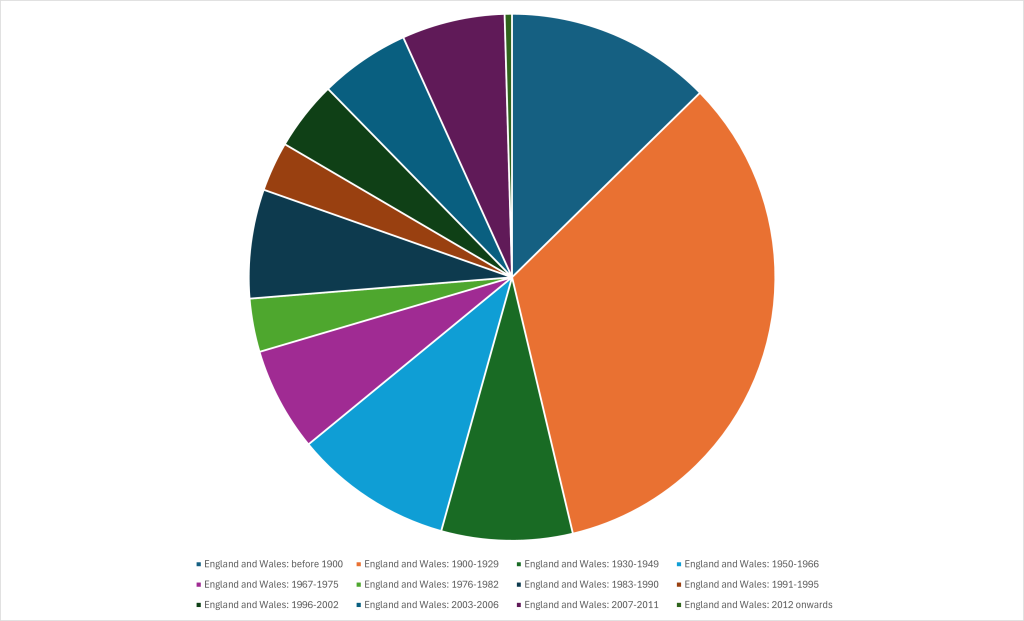
Understanding the age profile of private rented sector (PRS) properties in Swansea offers valuable insights into their construction characteristics and potential energy efficiency challenges. According to recent research, the distribution of PRS properties by age band reveals some striking patterns, with the majority of properties dating from the early 20th century, and a very small proportion of modern builds. This data is essential for energy assessors, landlords, and policymakers aiming to improve the energy performance of Swansea’s housing stock.
The Distribution of PRS Properties by Age Band
The research categorizes PRS properties in Swansea based on their construction periods as defined in the EPC methodology, with corresponding percentages of the total stock:
- Before 1900: 2,671 properties (12.57%)
- 1900-1929: 7,100 properties (33.42%)
- 1930-1949: 1,699 properties (8.00%)
- 1950-1966: 2,054 properties (9.67%)
- 1967-1975: 1,344 properties (6.33%)
- 1976-1982: 691 properties (3.25%)
- 1983-1990: 1,411 properties (6.64%)
- 1991-1995: 641 properties (3.02%)
- 1996-2002: 898 properties (4.23%)
- 2003-2006: 1,169 properties (5.50%)
- 2007-2011: 1,336 properties (6.29%)
- 2012 onwards: 95 properties (0.45%)
The largest single category of properties was constructed between 1900 and 1929, comprising 33.42% of the total PRS stock. This reflects Swansea’s historical development and indicates a significant proportion of older housing that may lack modern energy efficiency features.
There is however caution to be taken here, as there are anomalies in the 1900-1929 and Before 1900 categories when cross-referenced with wall type, which shows a lack of knowledge in assessors and it should be assumed that properties in the 1900-1929 category actually belong in the Before 1900 category.
Implications for Energy Efficiency and EPC Ratings
The age of a property is a key determinant of its construction methods, wall types, and insulation levels. Properties built before the introduction of building regulations requiring thermal insulation, such as those constructed before 1976, are likely to have poor energy efficiency unless retrofitted.
- Properties Before 1900: Often featuring solid stone or brick walls with little to no insulation, these homes can have high heat loss. Effective retrofitting measures, such as internal or external wall insulation, are key to improving their energy performance.
- 1900-1929 Properties: Many homes from this era are built with early cavity walls, which also lack insulation. These properties will typically require significant energy efficiency upgrades to meet modern standards.
- Post-1976 Properties: Homes built after the introduction of insulation requirements in the building regulations generally have better energy performance, with cavity wall insulation becoming more common. However, there is still room for improvement, particularly in properties from the 1980s and 1990s.
- Modern Builds (2012 Onwards): While these represent a very small portion of the stock (0.45%), they are likely to meet or exceed current energy efficiency standards, requiring minimal intervention.
Targeting Improvements to Achieve EPC Goals
For landlords aiming to meet the government’s minimum EPC rating requirements, the age band data highlights where efforts should be concentrated. Retrofitting older properties, particularly those built before 1930, will have the greatest impact. Measures such as wall and loft insulation, improved glazing, and efficient heating systems can make significant improvements in these homes’ EPC scores.
Properties from the mid-20th century also present opportunities for improvement, particularly those constructed before the widespread adoption of cavity wall insulation. By contrast, newer properties may require less extensive upgrades, such as improving the efficiency of existing systems or addressing specific areas like loft insulation.
Conclusion
The age profile of Swansea’s PRS properties reflects a housing stock that is heavily skewed toward older construction periods. With over 45% of properties built before 1930, addressing the energy efficiency challenges of these homes is critical for achieving government energy performance targets and reducing carbon emissions. By focusing on retrofitting measures tailored to each property’s construction characteristics, landlords can improve their EPC ratings, reduce energy bills, and enhance tenant comfort.
This data underscores the importance of understanding a property’s construction history as a foundational step in planning energy efficiency upgrades.